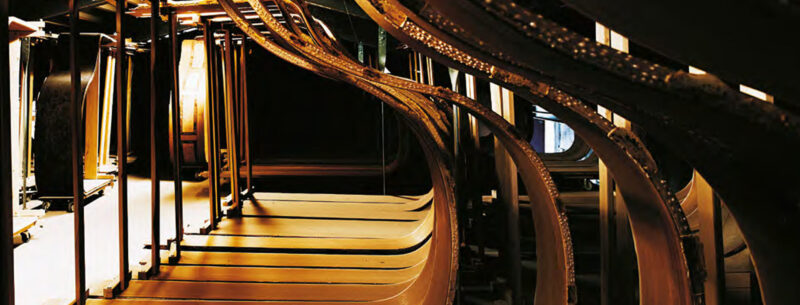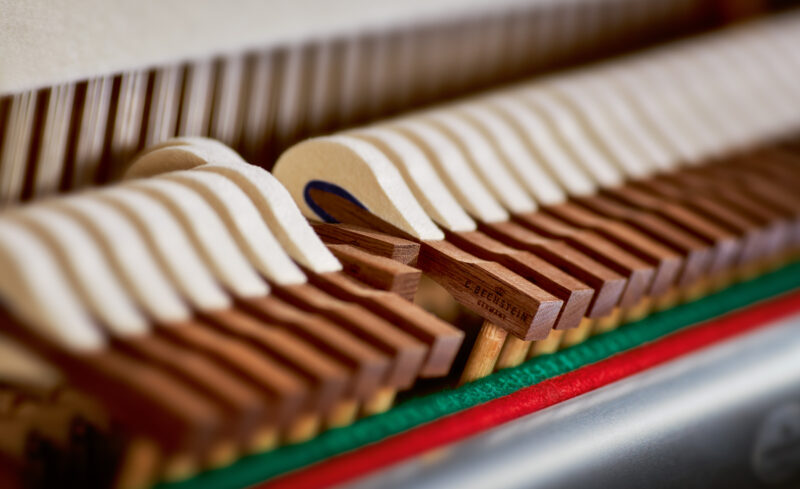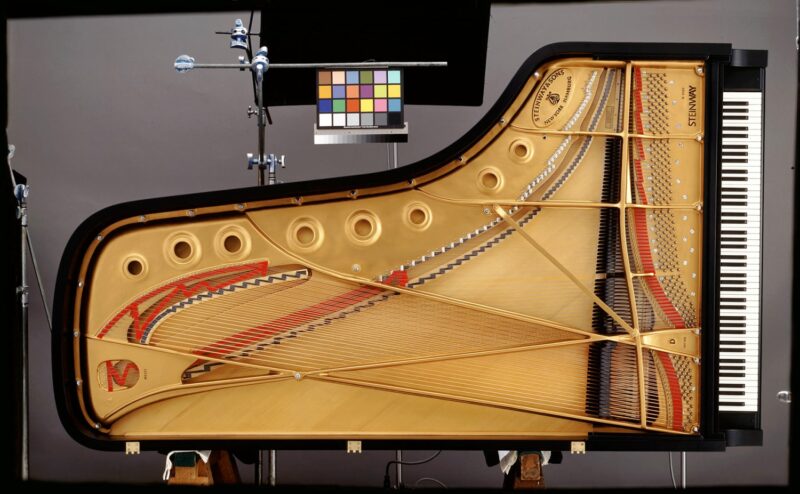If you’re a piano shopper or performer and you’re investigating the highest echelons of the piano business, it’s going to be awfully tough to miss these two titans – Steinway & Sons and C. Bechstein. Sure, there are a small handful of other pianos in the same top-quality tier that garner an equal level of musical respect, such as Bosendorfer, Fazioli and Steingraeber & Sohne, but no other two piano makers have achieved the same scale and dominance in their respective markets than Steinway or C. Bechstein have.
Whereas Fazioli and Bosendorfer sell just a few hundred units per year, C. Bechstein produces over 4,000 musical instruments annually in Seifhennersdorf Germany, and Steinway also remains well into the four-digit territory between their Hamburg Germany and New York factories.
But what many don’t realize is just how close in design these two instruments actually are, despite the fact that they are musically very different from one another.
In today’s article and companion video, we’re going to cover the musical and technical differences between Bechstein vs Steinway pianos. We’ll also look at their similarities, a rundown of their histories, and a snapshot of how things look for these manufacturers today.
Let’s start with C. Bechstein.
C. Bechstein

Early History
German company C. Bechstein has been producing pianos for over 150 years. Their story begins in the city of Berlin in 1853 when German Master Piano Maker Carl Bechstein began constructing highly personalized, bespoke upright pianos for the top artists of the day – a tradition of excellence with the vertical format that continues to the present day.
The small shop quickly grew to a large-scale operation, and by the turn of the 20th century, C. Bechstein was producing several thousand pianos annually.
WWII
At the height of C. Bechstein’s popularity, their pianos were the preferred choice of European and British aristocracy, as well as the preeminent concert halls of the day due to their superb build quality, musical capabilities and stunning cabinetry.
Unfortunately, the tensions and the destruction resulting from the two World Wars virtually ended the company. Luckily for us, C. Bechstein has undergone a complete rejuvenation over the past couple of decades.
Today
With new ownership and a massive investment of capital into the company, C. Bechstein has been experiencing a renaissance since the early 2000s. With the purchase of the already existing Bohemia Piano Factory in the Czech Republic, they’ve also begun producing pianos under the C. Bechstein Europe umbrella with the resurrected W. Hoffmann brand, serving as a high-value European alternative to the top-level professional Japanese pianos from Kawai and Yamaha.
In addition to that factory acquisition, they’ve also revamped many of their flagship piano models with more advanced scale designs, improved cabinetry, and very notably, a brand new action and hammer division, making them one of the few piano companies worldwide to manufacture their own hammers in-house.
Current Piano Lineup
In addition to the three quality lines from their Czech factory, C. Bechstein produces German-made upright and grand pianos in two quality levels. The lower-priced Academy Series line is on par quality-wise with the very best handmade Japanese pianos and certain other German companies.
The higher-priced C. Bechstein Concert Series sits right at the top of the heap for overall quality and craftsmanship in terms of what’s available anywhere in the world today.
With extensive recent redesigns throughout the entire C. Bechstein Academy and Concert Series lineups, the current C. Bechstein pianos are noticeably superior to what the company was producing even 10 to 15 years ago.
Certain C. Bechstein grand pianos and C. Bechstein uprights are regarded as the best pianos available for their specific size – the C. Bechstein Concert 8 is held by many as the finest upright piano money can buy, and the C. Bechstein C234 is widely considered as the best semi-concert grand piano currently in production.
Differences Between Academy and Concert Series Lines
Materials
Some of the specific material differences include the AAA Austrian white spruce in the Academy Series versus the much more expensive Val di Fiemme spruce used in the Concert series – this is an extremely rare red spruce, and is sourced from the same forest that Stradivarius cultivated for his legendary violins.
Mahogany hammer moldings are used in the Academy line versus the stronger and lighter walnut hammer moldings in the Concert line. From there, C. Bechstein uses the high-quality Silver Line Action in the Academy Series versus their top-tier Gold Line Action featured on the Concert Series. The geometry is quite similar between these two actions, but the Gold Line Action is built to an even stricter tolerance level.

Manufacturing Time & Designs
The manufacturing time for the Academy series is roughly half that of the time they spend on their Concert Series. Certain specific design differences include non-tapered soundboards in the Academy Series versus tapered soundboards in the Concert Series. A thicker, full hardwood rim with more laminations is used in the Concert Series along with solid beech bridges and a pinblock that also has more laminations, contrasted with a slightly thinner rim and less complex bridge design and pinblock in the Academy series.
There is some debate amongst C. Bechstein lovers throughout the world as to which design is superior. The mid-20th century C. Bechstein’s had a very romantic sound with a less complex tone and less projection often described as intimate.
The present-day C. Bechstein models use virtually every best practice and design feature known to the piano industry and as a result, the tone is probably described best as something falling between a Steinway and a Fazioli in terms of the dynamic response, extremely wide color pallet and staggering cabinet resonance.
Steinway & Sons
Early History
Steinway & Sons is without a doubt the most recognizable piano brand in the world. German immigrant Heinrich Engelhart Steinweg, eventually known as Henry E. Steinway, opened a small workshop in Manhattan in 1853 after years of piano making in Germany.
After obtaining over 100 design patterns, multiple location changes, and of course, anglicizing the family name to Steinway, Steinway would emerge as the dominant force in American piano manufacturing. In the 1880s, wanting to expand to the European market, Steinway opened a facility in Hamburg, Germany to supply Europe and the rest of the world.
Rise to Worldwide Prominence
Into the 1900s, Steinway became one of the most successful consumer brands in the world, pioneering many of the marketing techniques that we would now call product placement. Steinway Concert halls in London, New York, and Germany became the center of culture for many affluent and newly moneyed successful families and business people.
The newly minted Steinway Artist Program created and to this day maintained a monopoly among touring classical pianists.
Today
Steinway still produces pianos in both New York and Germany, with the New York factory supplying the Americas and the German factory supplying the rest of the world.
Steinway is no longer family-owned, and it has changed hands several times throughout the last 100 years. The company has had stable ownership since about 2013 after it was acquired by a New York-based private equity firm.
While the pianos from both factories are renowned for their quality, pianos from the German Hamburg factory are often regarded as superior to New York, though, there has been an effort in recent years to bring the American factory up to a similar standard that was established by its German counterpart.
Current Piano Lineup
New York Steinway

Steinway’s New York facility currently produces a single upright piano, the well-regarded 52” K52, which is available in a couple of different finishes.
In terms of the grand pianos, they offer a full lineup ranging from the 5’1” Model S baby grand piano to the 9’ Model D with four models in between. Their pianos are very popular in the high-end market among musicians and play the role of a sort of status symbol.
Despite improvements to quality consistency in recent years, the NY Steinway’s are still generally regarded as a step below their German counterparts.
Hamburg Steinway
Like the New York facility, Steinway’s Hamburg facility also offers the 52” K-52 as their only upright piano currently in production.
The grand piano lineup is the same except for one extra model, – the 7’5” C227. The German pianos are voiced quite differently from their American counterparts and do feature some differences in materials.
Differences between Bechstein vs Steinway
Sub-Brands
When we sit down to compare these two venerable brands, several key differences emerge. The first thing is their approach to their sub-brands and sublines. In Steinway’s case, we’re talking about the Boston and Essex lines, and with C. Bechstein, we’re talking about W. Hoffmann and Zimmermann.
Where Steinway elected to contract the construction of Boston to Kawai (Samick now manufactures one model as well) and Essex to a series of changing Chinese manufacturers, C. Bechstein directly manufactures all aspects of their five European-made lines and contracts the manufacturer of the Zimmermann line only.
The major differences between these two approaches has to do with consistency, both in terms of a model-to-model comparison, but also in terms of the overall quality of a given line from year to year.
For example, Essex have gone through different manufacturers over the years, with varying degrees of success. On the other hand, every single W. Hoffman acoustic piano from all three lines (Vision, Tradition, Professional) leaves C. Bechstein’s Czech factory with no detectable differences from one year of manufacture to the next.
Design

There are of course also a number of design differences between these two manufacturers when comparing lines of equivalent quality. Virtually every structural part of a Steinway grand is made with hard rock maple, including the rim. This focus on a specific, very dense wood colors the tone in a very distinctive way and also creates a very resonant structure.
C. Bechstein uses a variety of dense hardwoods in their grands as opposed to only maple. In addition to maple, they also use mahogany as well as beech. Whereas maple tends to produce a mid-range heavy tone with great projection, C. Bechstein’s use of multiple hardwoods combined with a super precise structure produces a tonal profile that is much closer to that of a Fazioli – very colorful, but with a dynamic response closer to that of a Steinway.
New York Steinway & C. Bechstein actions are also quite different. New York Steinways feature their patented Accelerated Action while C. Bechstein uses an action that is much closer to a Hamburg Steinway action. On first touch, C. Bechsteins feel lighter with a sense of a deeper key bed, whereas a Steinway will have a heavier touch and the sense that the key bed is more shallow.
Musical Differences
Musically speaking, Steinways tend to have a much more broad range of tone between dynamic extremes. In other words, the character of tone is quite different when playing softly versus when playing loudly. This is less consistent from model to model and less consistent through the top to the bottom of the range, however, whereas C. Bechstein’s tend to be extremely consistent throughout all ranges and across different models.
Steinway’s tend to have a slightly darker color in the upper range with less clarity, and the softer dynamic ranges are more notably flat in tone compared to a C. Bechstein. Bechstein’s are also known for their unique bloom-like character of tone.
What These Differences Mean
The real-world implications of these musical observations mean that anyone considering a Steinway will most definitely want to play the exact piano in the showroom that they’ll be taking home due to the lack of consistency from piano to piano and model to model.
This also brings us to another question people always ask; will a piano from either of these manufacturers increase in value over time? The short answer is no.
Although there are instances where one could sell their piano for more than they bought it for, i.e. a high-end piano purchased in the 1920s will of course sell for a higher price than one hundred years ago, this completely ignores the effects of inflation.
Ultimately, these instruments are highly complex machines that unfortunately do not improve with age over time. Unlike a violin or cello, in which age may legitimately make the instrument more valuable as the wood seasons, a piano is at its absolute peak at some point within the first five years of its ownership. When inflation is accounted for, the best that an owner can probably hope for is a lifetime of wonderful music-making with a slow and predictable depreciation against its replacement cost.
Similarities Between C. Bechstein & Steinway & Sons
Despite many differences, there are surprising similarities between these two manufacturers that not everyone is aware of. For one, C. Bechstein Concert and Hamburg Steinway grands use a treble bell in their larger models. This is something that was originally innovated by Steinway and later adopted by C. Bechstein.
A second similarity is that both manufacturers use a highly tapered, old-growth spruce soundboard in their top German instruments. Steinway doesn’t disclose their exact type of sourcing of spruce, but by all accounts, they still use Alpine Sitka. C. Bechstein on the other hand is a little more transparent in this regard and they use a minimum of 1,000-meter altitude red spruce from the Val di Fiemme, which is in Italy, of Stradivarius fame.
Closing Thoughts
We hope that you’ve enjoyed this exploration of the history, similarities and differences between C. Bechstein and Steinway & Sons pianos.
Thanks very much for reading, and be sure to check out the companion video!

